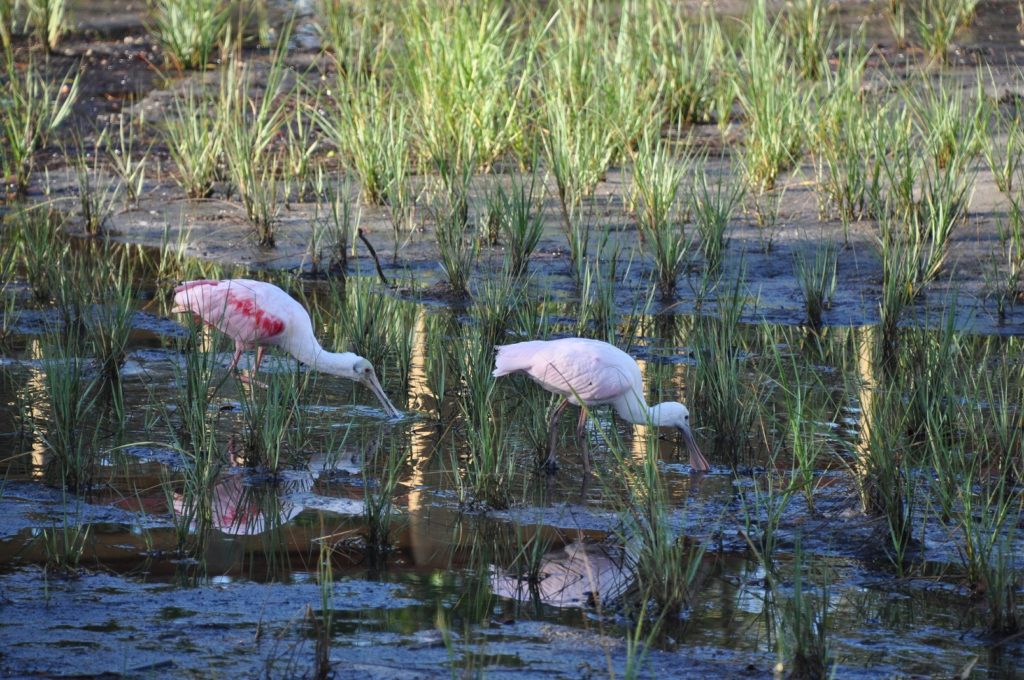By Marcia Biggs
SAFETY HARBOR – On the northwest shore of Old Tampa Bay, Safety Harbor’s Waterfront Park with its new scenic boardwalk is a favorite for sunset strollers. At dusk, the panoramic view reflects pastel shades of pink and blue on the clouds over the bay. Herons, roseate spoonbills and egrets fly overhead as they return to roost for the night. Dogs frolic with their owners in the adjacent open field, while boys play a game of soccer.
Six months after a habitat restoration effort removed tons of invasive plants, new coastal wetlands area is thriving.

A boardwalk meanders for nearly a half-mile above the wetlands and through the mangroves, offering magnificent views of Tampa Bay, along with the chance to see dolphins, pelicans, and other shorebirds. At low tide, egrets and herons explore the marshy estuary, pecking at the fiddler crabs and minnows which are easily accessible. The Florida West Coast Branch of the American Public Works Association honored the city’s Waterfront Park as Environmental Project of Year (2016-2017).
“You see a lot more birds now,” said city arborist Art Finn, who spearheaded landscaping during the restoration. “There’s a lot more food in the estuary for the birds now.”
Phase 1 of Restoration
Safety Harbor’s $1.8 million restored Waterfront Park officially opened on June 16. The 13 acres of shoreline property behind the Safety Harbor Resort and Spa was purchased by the city in 2012. The city went to work immediately by forming a steering committee which included parks and recreation officials, city engineers, and landscape designers. Grants were obtained from the Tampa Bay Environmental Restoration Fund ($70,000) and Florida Department of Environmental Protection Trails Program ($177,000). Permitting requests were submitted to Army Corps of Engineers, Southwest Florida Water Management District and Pinellas County.
Environmental studies, hiring contractors and hiring contractors to remove invasive plants and grade the property to restore tidal flow were part of the initial project work, said John Powell, head of the Safety Harbor Department of Engineering. A 10-foot-wide sidewalk was installed from the north end of the park to the south where Mullet Creek enters off the bay.
“The idea was to extend the Bayshore Linear Greenway Trail to Mullett Creek,” Powell said. The Bayshore Greenway Trail is a paved recreational trail that connects the Safety Harbor fishing pier and marina area south to State Road 60. It’s popular for bicyclers who can use it to connect to the bike trail which runs along the Courtney Campbell Causeway or the Ream Wilson Trail heading west.
A 15-member advisory committee of Safety Harbor residents helped to develop three park “concepts” and public input was solicited. The concepts included features from a bandshell and splash pads to a waterfront restaurant, a kayak launch and a boardwalk.
“The final park concept was designed incorporating or planning for the features mostly desired by the community,” said Powell, with final approval by city commission. “A kayak launch was part of the plan, too, but we realized it was too shallow to allow. We’re hoping to install a kayak launch at another property along Bayshore in the future.”
[su_carousel source=”media: 10091,10090,10089,10088,10087,10086,10085″ link=”image” target=”blank” width=”880″ height=”600″ responsive=”no” items=”1″ autoplay=”0″]
All slideshow photos by Marcia Biggs.
Phase 2 of Restoration
Phase 2 included the habitat restoration of 13 acres of uplands and wetlands. A community planting day on February 25 brought more than 200 helpers, including volunteers from Tampa Bay Watch, Tampa Bay Estuary Program and city staff and residents to help plant more than 12,600 seedlings, plugs and small trees.
“The area had been totally overgrown with exotics, especially Brazilian pepper, and lots of old concrete and trash had been dumped,” said city arborist Finn. “Prior to the plantings, we excavated it all out and regraded it to allow for propagation of mangroves. We removed some distressed mangroves on the uplands to build the boardwalk and minimize tidal impact.”
The diverse mix of new native plantings includes 1,800 black, white and red mangrove seedlings; coontie, muhly grass and cordgrass; wax myrtle and buttonwood trees; sea grapes, beautyberry, saw palmetto, firebush and coral bean.
In March and April, students from Channelside Academy, Canterbury School and Dowdell Middle Magnet School planted 5,800 Spartina alterniflora plugs grown by students as part of Tampa Bay Watch’s “Grasses in the Classes” curriculum.
“We have a year-round nursery where we grow Spartina alterniflora, or marsh grass,” said Jenna LoDico, Canterbury’s director of marine studies. “Students from all grades participate in the monitoring and growing. For Safety Harbor, 32 sixth-graders took 1,200 plugs – half of our nursery – to the restoration. It was very rewarding for the students.”
After the planting days, additional landscaping, benches, an osprey nesting pole, and finally, the boardwalk were installed. One segment of the boardwalk at the mouth of Mullet Creek is the perfect place to watch shorebirds feeding at low tide. Here the calm waters of the inlet are lined with mangroves, where tiny fish, crabs, snails and other marine critters flourish. It’s hard to resist the attraction of this magnificent habitat. And best of all, admission is free.
Marcia Biggs is a freelance writer living in Safety Harbor, FL
[su_divider]
